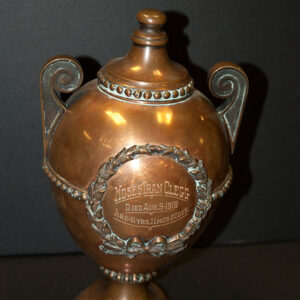calsfoundation@cals.org
Moses Tran Clegg (1876–1918)
Bacteriologist Moses Tran Clegg attracted international attention in 1909 when he reportedly became the first person to grow the leprosy bacillus in a laboratory. It was hoped that this breakthrough would lead to a vaccine to treat leprosy, also called Hansen’s disease, an infectious, disfiguring, and incurable disease caused by the bacillus Mycobacterium leprae. In addition to this achievement, Clegg also did research for the U.S. government on bubonic plague, amoebic dysentery, infantile paralysis, and cholera, and he coauthored scholarly bulletins on such bacteriological subjects as leprosy, amoebas, and parasitic protozoa.
Born on September 1, 1876, in Red Bluff (Jefferson County) to Joseph T. Clegg, who was an allopathic doctor, and Ida Daugherty Clegg, Moses Clegg received his primary education in small, private schools in Siloam Springs (Benton County). He entered the University of Arkansas (UA) in Fayetteville (Washington County) in 1892, though there is no evidence that he graduated. In 1898, he enlisted in Company A, First Arkansas Volunteer Infantry, during the Spanish-American War, then in the Hospital Corps, where he served on Corregidor Island during the Philippine Insurrection. This was presumably where he got his medical and scientific training, as in later years he was sometimes referred to with the honorific title of “doctor.”
After leaving the army, Clegg was appointed assistant bacteriologist for the Philippine Bureau of Science, overseen by the U.S. Public Health Service in Manila. It was there that he began his leprosy research and where, in 1909, he isolated and cultured the first leprosy bacilli, taken from both living and dead people who had leprosy. At this time, the Philippines had a reported 2,330 cases of leprosy, with 764 in Hawaii (which became a state in 1959) and just 146 in the United States. The disease caused tremendous suffering and stigmatization among the afflicted at a time when it was common practice to sterilize victims, then segregate them in isolated leper colonies—forcibly, if necessary.
Clegg’s breakthrough was widely publicized, with predictions that it would lead to a cure for leprosy. However, thirteen years later, Clegg’s obituary in the New York Times merely said that his discovery had “revolutionized the further research work in leprosy.” A history of the disease published in 1946 cast doubt on Clegg’s achievement, listing the “numerous observers” who also claimed to have cultivated leprosy bacillus and downplaying another scientist’s validation of Clegg’s discovery as being “probably a contamination.”
Clegg married Edna Wisner in Benton County in 1911, and the couple moved to Honolulu, Hawaii, where, for the next five years, he was the assistant director of the Leprosy Investigation Station. Following this, the Public Health Service sent him to San Francisco, California; New York City; and New Orleans, Louisiana, to work on finding treatments and cures for various infectious diseases.
In February 1918, Clegg was appointed superintendent of Queen’s Hospital in Honolulu, a facility specializing in leprosy treatment. Almost from his arrival, however, Clegg was unwell with the Bright’s disease (kidney failure) that would eventually cause his death. He died on August 9, 1918, at age forty-one, just six months after being made superintendent. (His death had erroneously been reported in the Arkansas Gazette in 1911.) His funeral was overseen by the Masonic lodge, of which he was a member. Cremation—virtually unknown in Arkansas at the time—was the norm in Hawaii, and Clegg’s body was cremated; his ashes were placed in an ornate copper urn and returned to Arkansas the following year.
Though Clegg and his father had reportedly been estranged for many years, Joseph T. Clegg took receipt of his son’s urn and oversaw its donation, by the Arkansas Medical Society (of which he been president in 1909), to the Arkansas History Commission. It remains in the Arkansas State Archives in the twenty-first century, despite the history commission’s later attempt to donate the urn and its contents to the city of Siloam Springs.
Edna Clegg gave birth to the couple’s third child shortly after her husband’s 1918 death. Following her return to Arkansas for the donation of the ashes, she and her children lived in poverty with her sister Grace in Little Rock (Pulaski County); she later remarried. The history commission and colleagues of Clegg attempted to interest the government in providing a pension or other financial relief to his widow and children, presumably without success.
For additional information:
“Arkansas Doctor Succeeds.” Batesville Daily Guard, March 30, 1909, p. 2.
“Deaths.” Arkansas Gazette, August 5, 1911, p. 4.
Gould, Tony. A Disease Apart: Leprosy in the Modern World. New York: St. Martin’s Press, 2005.
J. T. Clegg, J. C. Geiger, Dallas Herndon, and Gov. C. H. Brough Correspondence, 1918–1919. Arkansas State Archives, Little Rock, Arkansas.
Letter from Joseph T. Clegg to Dr. J. C. Geiger, August 27, 1918. Arkansas State Archives, Little Rock, Arkansas.
“Moses Tran Clegg; Bacteriologist, Noted for His Work in Leprosy, Dies in Honolulu.” New York Times, September 5, 1918, p. 11.
Rogers, Sir Leonard, and Ernest Muir. Leprosy. Baltimore, MD: The William and Wilkins Company, 1946.
Smith, Maggie Aldridge. Hico Heritage—Siloam Springs History, Vol. I. N.p.: 1976.
Abby Burnett
Kingston, Arkansas
 Early Twentieth Century, 1901 through 1940
Early Twentieth Century, 1901 through 1940 Health and Medicine
Health and Medicine Clegg Urn
Clegg Urn 




Comments
No comments on this entry yet.